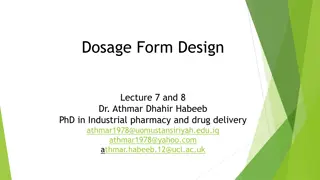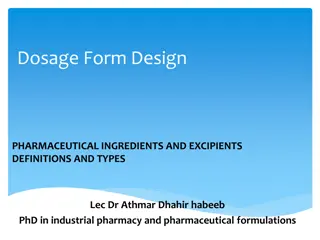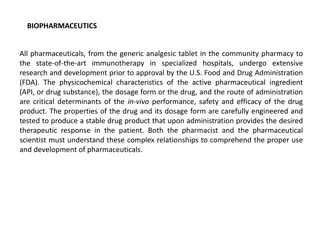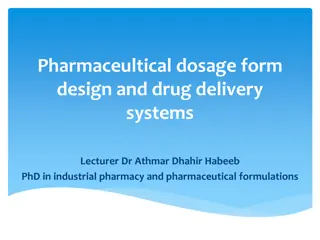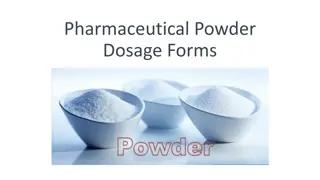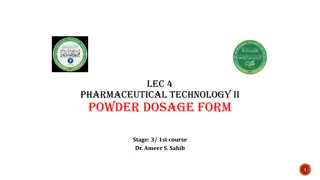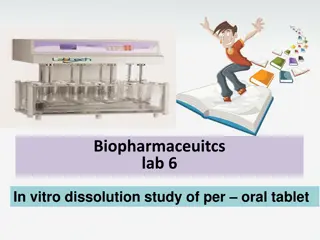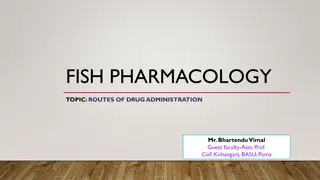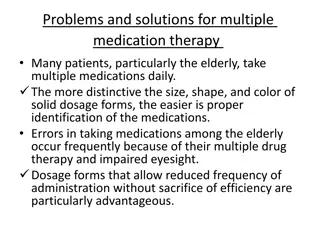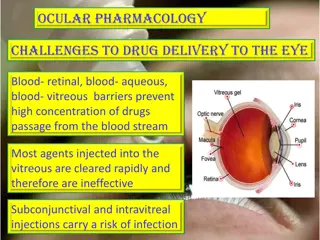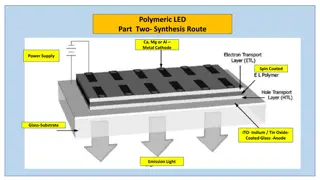Understanding Drug Administration Routes and Dosage Forms
This chapter explores the various routes of drug administration and dosage formulations, including oral, topical, and parenteral forms. It covers topics like inactive ingredients in tablets, suspension versus emulsion liquid forms, advantages and disadvantages of different formulations, stability of insulin, and correct administration techniques for various medications. Created by Jennifer Majeske from Mineral Area College.
Download Presentation

Please find below an Image/Link to download the presentation.
The content on the website is provided AS IS for your information and personal use only. It may not be sold, licensed, or shared on other websites without obtaining consent from the author. Download presentation by click this link. If you encounter any issues during the download, it is possible that the publisher has removed the file from their server.
E N D
Presentation Transcript
CHAPTER 4 Routes of Drug Administration and Dosage Formulations Created by Jennifer Majeske, Mineral Area College
LEARNING OBJECTIVES Differentiate between the terms route of administration, dosage form, and drug delivery system. Explain the properties of oral, topical, and parenteral dosage forms. Identify inactive ingredients and the various coatings of tablets and their functions. Differentiate between a suspension and an emulsion liquid dosage form. Identify dosage formulations utilizing the transmucosal route of administration. Created by Jennifer Majeske, Mineral Area College
LEARNING OBJECTIVES Define the emulsion characteristics of topical products such as ointments, creams, lotions, and gels. Explain the advantages and disadvantages of oral, topical, and parenteral dosage formulations. Discuss the importance of syringe selection for a diabetic patient. Contrast the advantages and disadvantages for insulin in multi-dose vials and prefilled insulin syringes. Created by Jennifer Majeske, Mineral Area College
LEARNING OBJECTIVES Understand the stability and expiration dates of insulin at room and refrigerated temperatures. Demonstrate correct techniques for administration of eyedrops, eardrops, metered-dose inhalers, and various parenteral injections. Differentiate among enteric-coated, sustained-release, and extended-release dosage formulations. Created by Jennifer Majeske, Mineral Area College
INTRODUCTION There exists many pharmacological agents with a variety dosage forms available to customize patient treatment. Pharmaceutics the study of the release characteristics of various dosage forms or drug formulations. Medications can be taken: orally, inhaled, injected, inserted, applied to the skin, and each route affects the drugs onset and duration of action. Pharmacokinetics the study of how drugs are absorbed, distributed, metabolized, and eliminated. Created by Jennifer Majeske, Mineral Area College
ROUTES OF ADMINISTRATION Route of administration a way to get a drug into or onto the body. What are the major routes of administration? Dosage form the physical manifestation of a drug such as a tablet, capsule, suspension, ointment, cream, patch or injection that is designed to deliver the medication by one or more routes of administration. Systemic effect the series of steps to get a drug into the bloodstream to exert its therapeutic effect. Created by Jennifer Majeske, Mineral Area College
ROUTES OF ADMINISTRATION Delayed systemic effect: Tablets, capsules, and oral liquids Immediate systemic effect: Parenteral injections, IV bolus and infusions Localized effect when a drug exerts its pharmacological action at or near the site of administration. Drugs administered by the transmucosal, topical and inhalation route Example: eardrop in the ear Created by Jennifer Majeske, Mineral Area College
ORAL ROUTE OF ADMINISTRATION Oral route of administration medication administered for absorption along the gastrointestinal (GI) tract into the systemic circulation. Oral can also refer to applying medication to the mouth. The abbreviation po from the Latin term per os, meaning by mouth , is used to indicate the oral route of medication on a prescription. Created by Jennifer Majeske, Mineral Area College
ORAL DOSAGE FORMS Tablets, capsules, solutions, suspensions, syrups and elixirs. Tablets and capsules are the two most common types and are inexpensive to manufacturer. The active ingredient in many tablets, capsules and suspensions are sometimes powders or granules. Drugs available in salt forms add shelf life to the product and/or to affect the release characteristics of the drug. Created by Jennifer Majeske, Mineral Area College
TABLETS Tablet a solid dosage form produced by compression. Tablets contain one or more active ingredient along with inert or inactive ingredients (excipients). Tablets are available in a variety of shapes, sizes, surface markings and coatings. Created by Jennifer Majeske, Mineral Area College
TYPES OF TABLETS Tablets can be designed to be easy to swallow, mask taste or exert an immediate pharmacological effect. Compression tablets are the most inexpensive and common dosage form. Acetaminophen (Tylenol) Multiple compression tablet (MCT) is made by multiple compression cycles and is a tablet on top of a tablet or a tablet within a tablet. Caplet a hybrid of a capsule and tablet; shaped like a tablet, coated like a capsule. Created by Jennifer Majeske, Mineral Area College
TABLET COATINGS Most compression tablets are not coated. Coatings improve flavor, appearance, or ease of swallowing. Sugar-coated tablet (SCT) contains an outside layer of sugar that protects the medication and improves appearance and flavor. Sugar coating makes tablets larger and heavier thus more difficult to swallow. Film-coated tablet (FCT) contains a thin outer layer of a polymer that can either be soluble or insoluble. Film coating are colored for an attractive appearance; taste-masking benefits can be lost if crushed. Created by Jennifer Majeske, Mineral Area College
SPECIAL DOSAGE FORMS Most tablets are designed to be swallowed whole and dissolve in the GI tract. Chewable tablet contains a base that is flavored and/or colored. It is designed to be chewed (masticated) and absorbed quickly for slightly faster onset. Oral disintegrating tablet (ODT) designed to melt in your mouth. ODT s are useful for pediatric and geriatric patients who may have difficulty swallowing or for patients with nausea. Created by Jennifer Majeske, Mineral Area College
CAPSULES The active ingredient of a capsule is in the form of a granular powder (liquid gel) enclosed by a gelatin shell. The body and cap may be sealed to prevent tampering. Diluent pharmacologically inert filler used in capsules. Some capsule formulations are designed to provide better absorption of drugs, with less side effects. Some medications that come in capsule form are substitutable with a tablet, others are not. Created by Jennifer Majeske, Mineral Area College
POWDERS AND EFFERVESCENT SALTS Powders and effervescent salts are used less frequently by patients, but offer some advantages over tablets and capsules. Powders preparations in the form of fine particles. Goody s headache powders Effervescent salts granules or coarse powders containing one or more medicinal agents, as well as some combination of sodium bicarbonate with citric acid, tartaric acid or sodium bisphosphate. Alka-Seltzer Created by Jennifer Majeske, Mineral Area College
LIQUIDS Liquids consist of one or more active ingredient in a liquid vehicle such as a solution or suspension. Most liquids are commercially available as solutions (elixirs and syrups), suspensions or emulsions. Created by Jennifer Majeske, Mineral Area College
COMMON SOLUTIONS Solution a liquid in which the active ingredients are completely dissolved in a liquid vehicle. Solutions can be classified as aqueous, alcoholic, or hydroalcoholic. Solvent the vehicle that makes up the greater part of the solution. Solute the ingredient dissolved in a solution. Created by Jennifer Majeske, Mineral Area College
COMMON SOLUTIONS Solutions are often classified by their ingredients; elixirs and syrups are the most common dosage forms of solutions. Elixir a clear, sweetened, flavored solution containing water and ethanol. Syrup an aqueous solution thickened with a large amount of sugar sucrose or sugar substitute. Syrups can contain additional flavors, colors or aromatics. Most pediatric formulations are syrups or elixirs. Created by Jennifer Majeske, Mineral Area College
LESS COMMON SOLUTIONS Aromatic water a solution of water containing oils or other substitutes that have a pungent, and usually pleasing smell. Extract potent dosage form derived from plant or animal sources which most or all of the solvent has evaporated to produce a powder, an ointment like form, or a solid. Fluidextract a liquid dosage form prepared by extraction from plant sources and commonly used in the formulation of syrups. Tincture alcoholic or hydroalcoholic solution of extractions from plants. Spirit alcoholic or hydroalcoholic solution containing volatile, aromatic ingredients. Created by Jennifer Majeske, Mineral Area College
SUSPENSIONS Suspension the state of a substance when its solid particles are mixed with but undissolved in a liquid. Dispersion the medication is simply dispersed or distributed throughout the vehicle, creating an incomplete mixture of solid and liquid. Suspensions contain inactive ingredients such as colorings, flavorings and coatings. Some suspensions are commercially available, others come in the form of powders that must be reconstituted prior to dispensing. Created by Jennifer Majeske, Mineral Area College
EMULSIONS Emulsion another type of dispersion; a mixture of two immiscible or unblendable substances. What is an example of an emulsion? Emulsions contain an emulsifying agent that renders the emulsion stable and less prone to separate. Created by Jennifer Majeske, Mineral Area College
COLLOIDS Colloid a mixture having physical properties between those of a solution and a fine suspension. Magma or milk like liquid, is an example of a dispersion containing ultrafine colloidal particles that remain distinct in a two-phase system. Microemulsion another type of colloidal dispersion; a liquid that is dispersed in another. Created by Jennifer Majeske, Mineral Area College
ADVANTAGES AND DISADVANTAGES OF CERTAIN ORAL DOSAGE FORMS What are some common advantages and disadvantages to administering a drug using the oral route? Tablets Capsules Liquids Created by Jennifer Majeske, Mineral Area College
DISPENSING AND ADMINISTRATION OF ORAL DOSAGE FORMS Patients should be counseled by the pharmacist what drinks and foods to take or not take with medications. Patients should be counseled by the pharmacist on behaviors to avoid while taking medications. Auxiliary labels are affixed to drug containers to ensure that patients are taking medications in the correct manner. Patients should be reminded of proper storage conditions. Created by Jennifer Majeske, Mineral Area College
ORAL SYRINGES Oral syringe measures and delivers oral liquid medications to pediatric patients. This type of syringe is a calibrated device consisting of a plunger and cannula, and is used without a needle to administer medications to the mouth. Oral syringes can be used to slowly administer liquid medications. Very small doses (less than 1 mL) can be administered with a tuberculin syringe (without a needle). Created by Jennifer Majeske, Mineral Area College
MEDICATION CUPS & DROPPERS Manufacturers often provide a medication cup for OTC liquids. These are plastic cups that contain specific dose demarcations in different units of measure. Droppers offer the ability to deliver the correct dosage of smaller volumes of medication. Dropper contains a small squeezable bulb at one end and a hollow glass or plastic tube with a tapering point. Viscosity the thickness and flow characteristics of fluids. Created by Jennifer Majeske, Mineral Area College
TRANSMUCOSAL ROUTE OF ADMINISTRATION Transmucosal route of administration allows the drug to be absorbed through or across the sieve-like or permeable mucous membranes of the mouth, eyes, ears, nose, rectum, vagina and urethra. What advantages are there to using a transmucosal route of administration? Transmucosal dosage forms include: tablets, gum, and lozenges (sublingual); ointments, solutions, suspensions, and sprays (eyes, ears, and nose); suppositories and solutions (rectum, urethra, and vagina). Created by Jennifer Majeske, Mineral Area College
SUBLINGUAL MEDICATIONS Sublingual route of administration sub meaning under and lingua meaning tongue ; the tablet is placed under the tongue, where it is rapidly absorbed by blood vessels. Created by Jennifer Majeske, Mineral Area College
BUCCAL MEDICATIONS Buccal route of administration a drug absorbed by the blood vessels in the lining of the mouth. What are some examples of drugs administered via this route? Lozenge troche, solid dosage form containing active ingredients and flavorings, that are dissolved in the mouth. Created by Jennifer Majeske, Mineral Area College
OPHTHALMICS, OTICS, AND NASAL SPRAYS/SOLUTIONS All can be delivered to a specific site with a minimum of systemic side effects. Irrigating solution a solution for cleansing or bathing an area of the body, can be used both topically as well as instilled. Ophthalmics Ocular route of administration application of a drug into the eye. Conjunctival route of administration the application of a drug to the conjunctival mucosa. Created by Jennifer Majeske, Mineral Area College
OPHTHALMICS, OTICS, AND NASAL SPRAYS/SOLUTIONS Otics Otic route of administration the application of a drug into the ear canal. Eardrops can never be used in the eye, but eyedrops can be used in the ear. Nasal sprays/solutions Intranasal route of administration the application of a drug into the passages of the nasal cavity. Spray a dosage form that consists of a container having a valve assembly unit, when activated, emits a fine dispersion of liquid. Created by Jennifer Majeske, Mineral Area College
SUPPOSITORIES AND SOLUTIONS Suppository an example of a semisolid dosage form that is created from an inactive ingredient and formulated to melt at body temperature and release an active drug. Created by Jennifer Majeske, Mineral Area College
SUPPOSITORIES AND SOLUTIONS Rectal suppositories/solutions Rectal route of administration used to deliver drugs into the rectum. Enema a water-based solution administered rectally for cleansing or evacuating the bowel before a GI procedure. Vaginal suppositories/solutions Vaginal route of administration the application of any drug within the vagina. Urethral suppositories/solutions Urethral route of administration the application of a drug within the urethra. Created by Jennifer Majeske, Mineral Area College
ADVANTAGES AND DISADVANTAGES OF CERTAIN TRANSMUCOSAL DOSAGE FORMS Sublingual medications Advantage: rapid onset Disadvantage: short duration Buccal medications Advantage: faster onset Disadvantage: dose dumping Ophthalmics, otics, and nasal sprays/solutions Advantage: fast onset Disadvantage: Created by Jennifer Majeske, Mineral Area College
ADVANTAGES AND DISADVANTAGES OF CERTAIN TRANSMUCOSAL DOSAGE FORMS Suppositories and Solutions Rectal suppositories/solutions Advantage: used in both old and young Disadvantage: patient inconvenience Vaginal suppositories/solutions Advantage: self-treatment Disadvantage: Created by Jennifer Majeske, Mineral Area College
DISPENSING AND ADMINISTRATION OF TRANSMUCOSAL DOSAGE FORMS Sublingual medications storage requirements; nitroglycerin. Buccal medications chewing differences between regular gum and nicotine gum Ophthalmics, otics, and nasal sprays/solutions Ophthalmics administered at or near room temperature; Fig. 4.2 Otic store at room temperature; Fig. 4.3 Nasal medications used for relief of nasal congestion or prevention of allergy symptoms Created by Jennifer Majeske, Mineral Area College
DISPENSING AND ADMINISTRATION OF TRANSMUCOSAL DOSAGE FORMS Suppositories and solutions certain preparatory steps and administrative techniques Rectal medications proper storage and administration Vaginal medications use medication for prescribed time period; Table 4.4 Proper Technique for Administration of Vaginal Medications, pg. 126 Created by Jennifer Majeske, Mineral Area College
TOPICAL ROUTE OF ADMINISTRATION Topical route of administration application of a drug directly to the surface of the skin; exert local effects; side effects are minimal. Ointments, pastes, and plasters Ointment a dosage form that is a water-in-oil (W/O) emulsion a formulation that contains a small amount of water dispersed in oil. Liniment a medicated topical preparation Paste like an ointment that contains more solid materials, creating a dense consistency. Plaster a solid or semisolid that adheres to the body and contains backing material such as paper, cotton, linen, silk, moleskin, or plastic. Created by Jennifer Majeske, Mineral Area College
TOPICAL ROUTE OF ADMINISTRATION Creams, lotions, and gels Cream an oil-in-water (O/W) emulsion a small amount of oil dispersed in water. Lotion another O/W emulsion for topical application. Gel contains solid particles in a liquid, but the particles are fine or ultrafine. Jelly a gel that contains a higher portion of water in combination with a drub substance and a thickening agent. Glycerogelatin a topical preparation made with gelatin, glycerin, water, and medicinal substances. Colloid a mixture with physical properties that fall between a solution and a fine suspension. Irrigating solutions douche, is often reconstituted from a powder and introduced into the vaginal cavity for local cleansing. Created by Jennifer Majeske, Mineral Area College
ADVANTAGES AND DISADVANTAGES OF CERTAIN TOPICAL DOSAGE FORMS Major advantage of topicals is they have a fast onset of action with relatively few systemic side effects. Ointments Advantage: especially good for extremely dry areas of skin Disadvantage: appearance and greasy residue Creams, lotions and gels Advantage: apply more smoothly to the skin and leave a very thin film Disadvantage: Created by Jennifer Majeske, Mineral Area College
DISPENSING AND ADMINISTRATION OF TOPICAL DOSAGE FORMS Ointments risk of increased absorption; careful application of topical medications; nitroglycerin; corticosteroid ointments. Creams, lotions, and gels specific precautions that patients should follow during application. Created by Jennifer Majeske, Mineral Area College
INHALATION ROUTE OF ADMINISTRATION Inhalation route of administration the application of a drug through inhalation into the lungs, typically through the mouth. Inhalation Dosage Forms: Aerosols and MDIs Aerosol a spray in a pressurized metered-dose container that contains a propellant Metered-dose inhaler (MDI) a handheld, propellant-driven device, an MDI provides a specific measured amount of medication with compressed gas. Created by Jennifer Majeske, Mineral Area College
INHALATION DOSAGE FORMS Sterile Solutions and Nebulizers Nebulizer atomizing machine that delivers medication as a mist Volatile Medications and Vaporizers Used to deliver moisture to the air for relief of cold systems Micronized Powders and Nonaerosolized Inhalers Breath-activated powder for inhalation to avoid propellants Administers a higher concentration of drug as a micronized powder into the lungs Created by Jennifer Majeske, Mineral Area College
ADVANTAGES AND DISADVANTAGES OF CERTAIN INHALATION DOSAGE FORMS Major advantage of inhalation dosage forms is the rapid onset of action, which is only second to the IV route of administration. Major disadvantage is poor inhalation technique, with all MDIs; higher risk of side effects with larger amounts of medication. Created by Jennifer Majeske, Mineral Area College
DISPENSING AND ADMINISTRATION OF INHALATION DOSAGE FORMS The more immediate-acting drug when using multiple MDIs should be used first, followed by the second 5-10 minutes later. Table 4.5 Proper Technique for Administration of an MDI, pg. 132 Spacer device the medication is released into a storage chamber where it can be more easily inhaled by the patient. The patient should be sure to rinse their mouth after administration of an MDI to prevent an oral fungal infection. Created by Jennifer Majeske, Mineral Area College
PARENTERAL ROUTE OF ADMINISTRATION Parenteral solution a sterile or microbial-free solution (w/ or w/o medication) that is administered via a hollow needle or catheter inserted through one or more layers of skin. Parenteral comes from the Greek roots para meaning beside and enteron meaning intestine. This route bypasses or goes beside rather than through the alimentary canal or GI tract. Parenteral route of administration the injection of any drug or fluid into the bloodstream, muscle, or skin. Created by Jennifer Majeske, Mineral Area College
PARENTERAL DOSAGE FORMS IV Route one of the more common parenteral routes of drug and fluid administration. Intravenous (IV) infusion a method for delivering a large amount of fluid and/or high concentration of medication directly into the bloodstream over a prolonged period and at a slow, steady rate. IM Route used to administer antibiotics, narcotics, medications for migraine headaches and vaccines. Injection administration of a parenteral medication into the bloodstream, muscle or skin Created by Jennifer Majeske, Mineral Area College
PARENTERAL DOSAGE FORMS Subcutaneous route administer medications below the skin into the subcutaneous tissue. What are some common medications administered subcutaneously? ID route used for diagnostic and allergy skin testing, local anesthesia, and various diagnostic tests and immunizations. What ID administrations mentioned in your text? Created by Jennifer Majeske, Mineral Area College
ADVANTAGES AND DISADVANTAGES OF CERTAIN PARENTERAL DOSAGE FORMS The parenteral route is used for medications that contain molecules that are unstable, to large for absorption, or broken down to quickly in the stomach or liver. IV route preferred route of administration in an emergency situation; rapid action to control and treat symptoms. IV bolus injection administration of a drug all at once. IV infusion continuous amount of needed medication over a given period. Created by Jennifer Majeske, Mineral Area College
ADVANTAGES AND DISADVANTAGES OF CERTAIN PARENTERAL DOSAGE FORMS Pyrogens fever-producing by-products of microbial metabolism. Embolism blockage of a vessel. Phlebitis a severe painful reaction at the injection site. IM route offers a more convenient way to deliver injectable medications; slower onset than IV administration; duration of action is much longer, making it more practical for use outside of a hospital setting; unpredictable rate of absorption. Created by Jennifer Majeske, Mineral Area College


